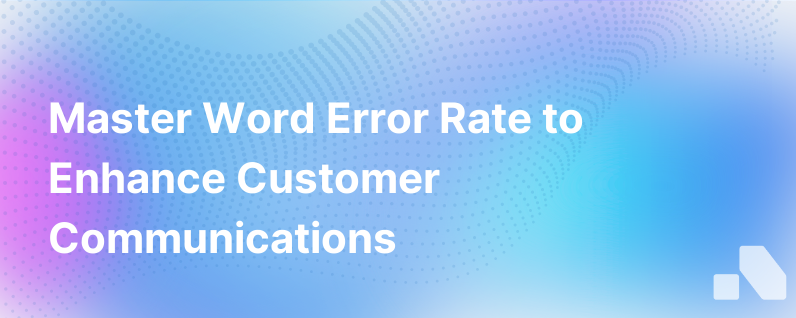Word Error Rate
Published on November 1, 2023 by Sawyer Middeleer
In the arena of B2B sales, the difference between a won and lost deal can often hinge on the clarity and precision of communication. For industries relying on voice recognition and transcription technologies, particularly those involving sales calls, customer support, and CRM systems, the importance of accurate speech-to-text conversion cannot be overstressed. This is where Word Error Rate (WER) becomes a metric of paramount importance. Below, we elaborate on what WER is, its implications for B2B sales, and how businesses can strive to achieve optimum WER.
Understanding Word Error Rate (WER)
Word Error Rate is a standard measurement used to assess the accuracy of speech recognition and transcription systems. It computes the percentage of errors by comparing the transcribed text produced by the system against a reference transcript that is considered correct. The errors accounted for in the WER calculation include substitutions (wrong words), deletions (missing words), and insertions (extra words).
For B2B sales organizations integrating voice into their systems, a high WER can indicate poor speech recognition performance that may result in miscommunication, data inaccuracies, and ultimately, missed opportunities.
The Relevance of WER in B2B Sales
In the B2B sales process, every interaction is a critical component of the sales pipeline. Sales reps spend a significant part of their day making calls, and they rely heavily on CRMs to document and track these conversations. Advanced CRMs employ speech-to-text technologies to transcribe calls, making WER a critical factor in ensuring the accuracy of captured data.
A low WER is indicative of reliable transcription, meaning that key information from customer interactions is preserved accurately. This in turn supports data-driven decision-making and ensures that follow-ups and sales strategies are based on the correct interpretation of customer needs and responses.
The Utility of Accurate Transcriptions in B2B Sales
Accurate call transcriptions enable sales teams to:
- Review and analyze sales calls to improve sales tactics and strategies.
- Share best practices by examining successful sales interactions.
- Train new sales representatives by providing real-life examples of successful pitches.
- Gain insights into customer pain points, objections, and preferences.
It's clear, then, that achieving a low WER is not merely a technical pursuit but a business necessity for B2B sales teams.
How WER Affects Customer Relations and Revenue
Beyond internal uses, the accuracy of transcribed speech can affect customer relationships. Errors in transcription may lead to misunderstandings or misrepresentations of a customer's intent, which can cause frustration, erode trust, and potentially lead to lost sales.
Moreover, in complex B2B sales cycles where multiple stakeholders are involved, maintaining a clear record of conversations serves as a safeguard against miscommunication. It also serves a legal purpose, providing documentation of what was agreed upon during sales negotiations.
Tackling WER Challenges in B2B Sales Environments
Reducing the Word Error Rate is essential, but it poses significant challenges, especially in the dynamic and often noisy environment of sales calls. Here are some steps B2B companies can take to mitigate WER challenges:
1. Training Custom Speech Recognition Models: Speech recognition models can be trained on industry-specific terminologies and the linguistic nuances typical of B2B sales dialogues.
2. Enhancing Audio Quality: Ensuring high-quality audio recordings reduces the number of inaccuracies in transcription by reducing background noise and improving speaker clarity.
3. Continuous System Training: Regularly update your speech recognition systems with new data to handle diverse accents, speech patterns, and pace variations often seen in sales calls.
4. Employing human oversight: Consider having a human review the transcriptions for accuracy. Although this adds a layer of manual work, it significantly improves the quality of the data fed into the CRM.
Conclusion
In the sphere of B2B sales, where every word counts, minimizing WER in speech recognition systems can have far-reaching implications on sales outcomes, customer relationships, and overall business success. As technology continues to advance, leveraging tools like AI and machine learning becomes imperative to edge out competition and to tighten the feedback loop between your offerings and the voice of your customer.
For businesses looking to refine their sales strategies with AI tools that deliver real-time account research, competitive insights, and personalized sales content, platforms like Aomni can open new dimensions in strategic selling, enabling sales teams to focus on what they do best—closing deals—while ensuring accurate and actionable data capture with minimal word errors.
Sources:
- Word error rate
- What Word Error Rate (WER) Is & What it Means | Rev Blog
- Is Word Error Rate Useful?
- Understanding Word Error Rate (WER) in Automatic Speech Recognition (ASR)
- What Is Word Error Rate? Measuring the WER of Machine-Generated Transcripts and Its Limitations
- The Problem with Word Error Rate (WER)
- Breaking Down Word Error Rate: An ASR Accuracy Optimization